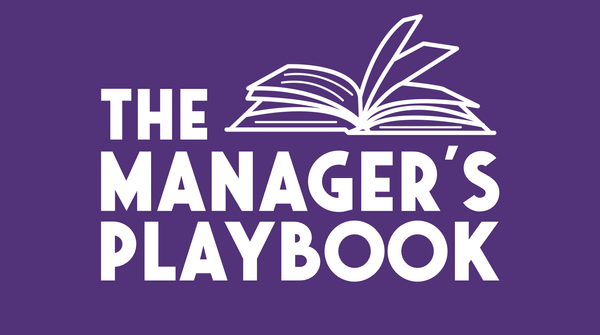The Art of Communication Design: Identify Your Audience
In this 3rd post of the series, we'll look at the target audience for your comms, and we'll examine the audience breakdown, audience journey and audience core needs.
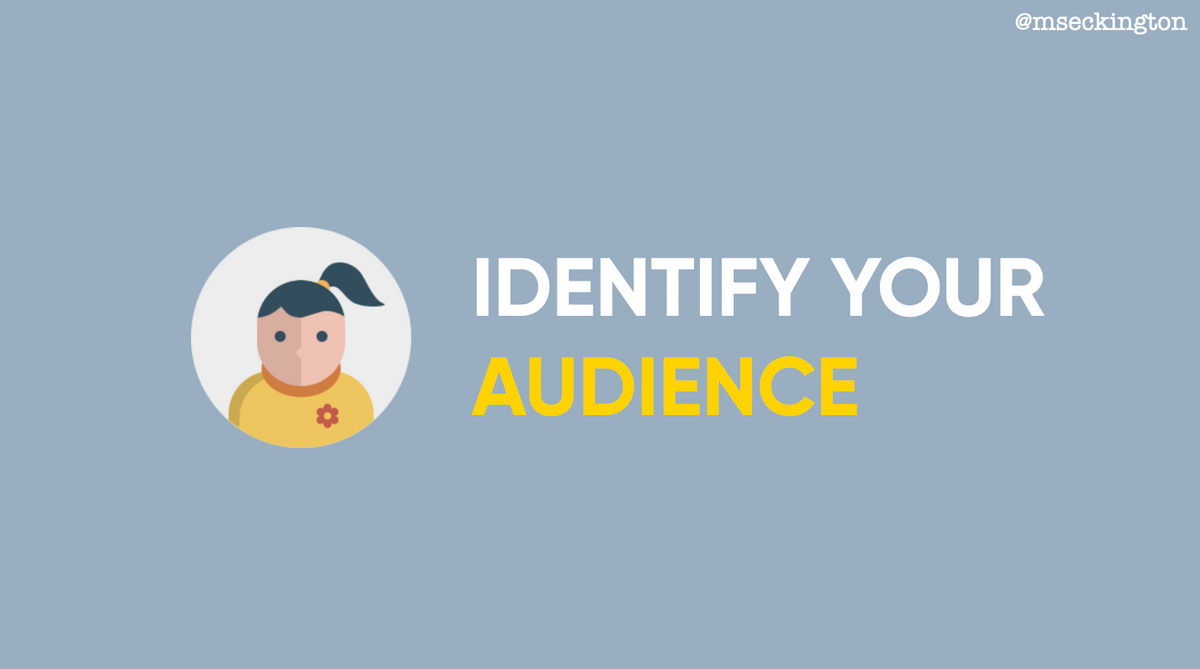
In this 3rd post of the series, we'll be taking a closer look at your target audience for your comms. Check out the entire series:
- Part 1: Intro
- Part 2: Define Your Goals
- Part 3: Identify Your Audience
- Part 4: Design Your Comms Plan
- Part 5: Design Each Message
Last month I gave this talk at DevRelCon London. This blog post series is a slightly adapted version of my speaker notes, so that it’s split out across multiple posts and hopefully reads better as articles. If you prefer watching videos, check out the talk on the DevRelCon YouTube channel.
Once you’ve figured out what the goals of your comms are, your next step is to look at your target audience.
We’ll look at 3 different aspects here:
- Audience breakdown: who are your target audiences?
- Audience journey: what impact do you want on your audiences?
- Audience needs: what core needs does your audience have?
Audience breakdown: Who are your audiences?
Often when people start considering their comms, they start thinking about who their target audience is, as if it’s a singular specific group. To me though it’s more useful to take some time to consider what subsets of audiences you have: who are your audiences?
Unless you’re planning your comms for 1 specific person (which I mentioned earlier may well be the case), you’re more likely to be aiming your comms to multiple people, with different attributes, backgrounds and needs.
I’m not saying that you need to consider every person individually, but be wary of making too large buckets for your audience. It’s very easy to generalise and not realise that by doing so you’re missing nuances needed in your comms.
Think about the subsets or the slices of groups that you’re trying to target — what makes them distinct?

Your first exercise about your target audience: create an audience breakdown. Consider all the different groups that you want to target with your comms.
Think of individuals, teams, communities, volunteers, stakeholders, execs — I can continue listing types of groups, but this will be super dependent on your context.
For some of you, your audiences will be internal to your company. It may be specific product teams, your entire engineering team or teams in other departments. For others, your audiences will be external to your company, like specific users, communities or volunteers.
Here’s an internal example: let’s say because of strategy changes there’s a product team that’s being disbanded and it’s members re-distributed over other teams. Who are the different audiences that you want to communicate with? I’d consider your target audiences to be the product team that is being disbanded, the other product teams and potential stakeholders. Depending on the team, you might want to consider specific team members of that product team as different audiences too.
Now how about an external example where there might be different ways of looking at your target audiences: let’s say we’re running a hackathon to promote our new APIs and we want to look at communicating to potential attendees. We could consider all potential attendees as a single target audience, but that doesn’t help us that much since it’s quite a big nebulous group. What are the different subgroups that are relevant? One way is to split it out by different ways we might contact potential attendees, like previous hackathon attendees, current users, and social media followers. Another way would be to look at the different type of programming languages communities that are relevant to our APIs.
There’s no one way of making subsets of your audience. Sometimes it helps of simply being aware of the various lenses that you can apply here.
The other benefit of writing out the target audiences for your comms (just like in the previous post about writing out your comms goals) is to make sure all your team members are on the same page, especially when you’re coordinating something complex to communicate. Are you all considering the same audiences? Are you making sure you have all audiences covered?
Think about the target audiences that make sense for what you want to communicate. Where are the differences? Which differences do you need to be aware of and need to lean into?
The point is to understand the different types of audiences you want to communicate to, primarily to understand how the messaging and the goal of the comms may be different for these specific audiences.
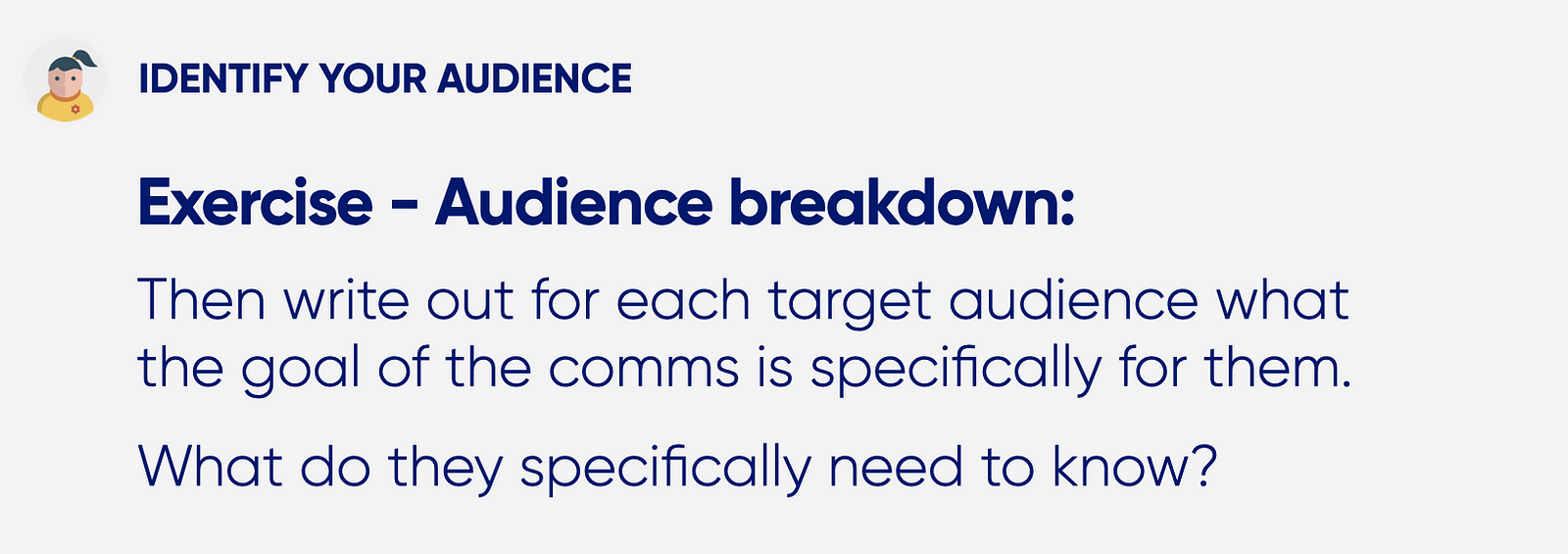
That brings us to the second part of this exercise: write out for each of these groups what the goal of the comms is for them. What do they specifically need to know? How does that change with each group? What variations are there?
This doesn’t necessarily mean that you’ll be creating specific messages for each of these audiences; you might decide that you’ll use the same channel and message to all your target audiences. Rather this is about identifying all the possible perspectives you might get, so that when you get around to designing the messaging, you can shape it in the right way and take all the different goals into account. In the next blog post, we’ll be looking at how to do that. For now, we just want to focus on understanding the different perspectives your comms need to address.
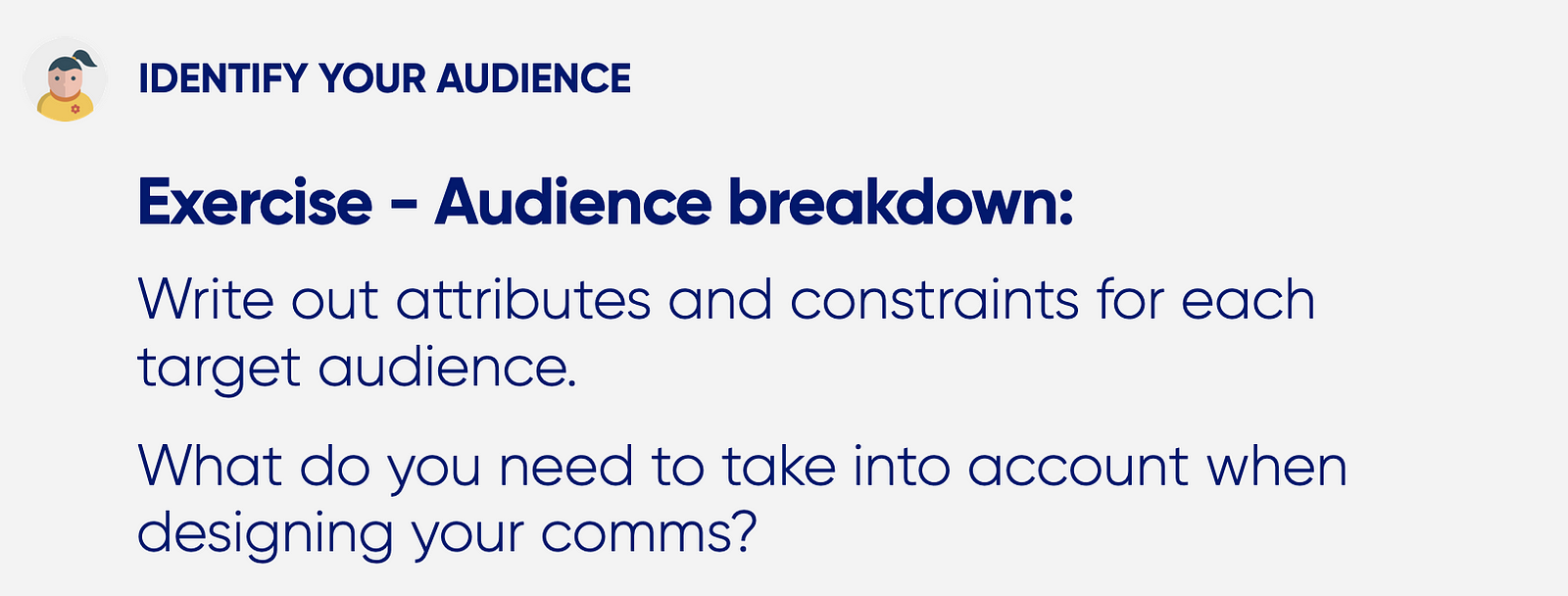
The third step of the audience breakdown exercise is to think of the attributes and constraints of these audiences. What is important to keep into account when designing comms for them?
So this could be things like: this specific community only interacts with us on IRC, while this other community has a mailing list and Discord. This product team’s sprint cycle starts on Monday, while this other product team’s sprint cycle starts on Tuesday.
Also think about what I mentioned in the intro blog post: there’s lots of different languages, different cultures, different backgrounds of audiences that we may interact with — how will those things effect the way you communicate with your target audiences?
Audience journey: what impact do you want on your audiences?
The next step is looking at what type of impact do you want on your audience. What is that you’re trying to do with them? What journey do you need to take them on?
Let’s go back to Stephen McGarvey’s concept of current state:
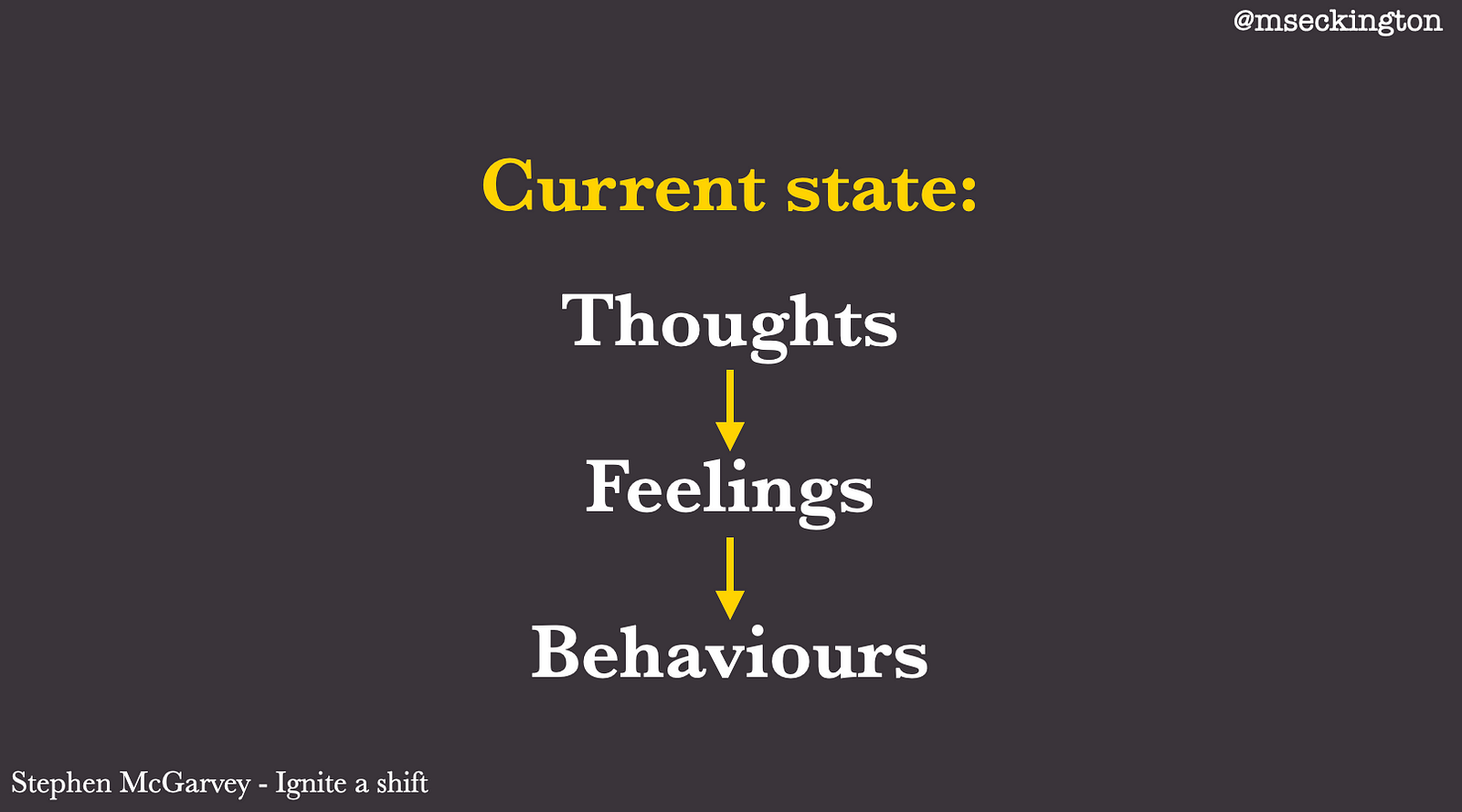
A person’s current state consists of several things: their thoughts, their feeling and their behaviours. Most of the time these are all related to each other. A person will think something, that will lead them to feel something, which will make them behave in a certain way.
What are they currently thinking, feeling and doing?
Now this also applies to the desired state: you want to get them to think a certain way, so that they feel a certain way, so that they’ll behave a certain way.

In the previous exercise you defined what the goal of your comms with the target audience is. Now you need to be thinking about how do you lead them there? What journey do you want to take your audience on to get someone to that desired state?

So in this exercise you want to create an audience journey overview — I’ve mentioned this in previous presentations as a Think Feel Do overview.
First look at the current state:
Feel: What do they currently feel?
Do: what actions are they currently taking? What is driven by those thoughts and feelings?
Then think about your desired state:
Feel: What do you want your audience to feel?
Do: what actions do you want the audience to take after the comms? What new behaviour do you want to see from them?
The main benefit of doing this exercise is to really understand that shift between the two states: what are they thinking, feeling and doing before your comms? And how does that all change after your comms?
Audience needs: what core needs does your audience have?
The third area about identifying your audience that we want to look at are your audiences’ needs. What are their core needs?
So for this we’ll be looking at the BICEPS model from Paloma Medina. I first heard about this in Lara Hogan’s blog post about team desk moves, and it’s great way to reflect on what people need when you communicate with them.
The BICEPS model looks at the 6 core needs that are important to humans in both their work and personal lives. Each of us will have our own individual order of these needs, and we might also have different orders for these needs depending on the situation.
So the 6 BICEPS core needs are:
Belonging: This is about feeling connected, feeling part of a community
Improvement: This is about growth and progress.
Choice: Having control, autonomy and flexibility over things
Equality: Making sure that things are fair and equitable.
Predictability: Having certainty about when and how things are going to happen
Significance: Knowing how you fit in, what your purpose is.
There are nuances to all of these, and this is just a short recap, so I recommend taking a closer look at both Paloma’s and Lara’s posts to understand this in more detail.
Take the time to think about your target audiences and understand how their core needs might be affected by what you’re communicating. Cause understanding these core needs will help shape how and what to communicate. Thinking about these will help frame and might give a different perspective on what you need to take into account.
Not every thing that you communicate will have these core needs affected, but it’s useful to think about how what you’re communicating might affect someone’s needs.
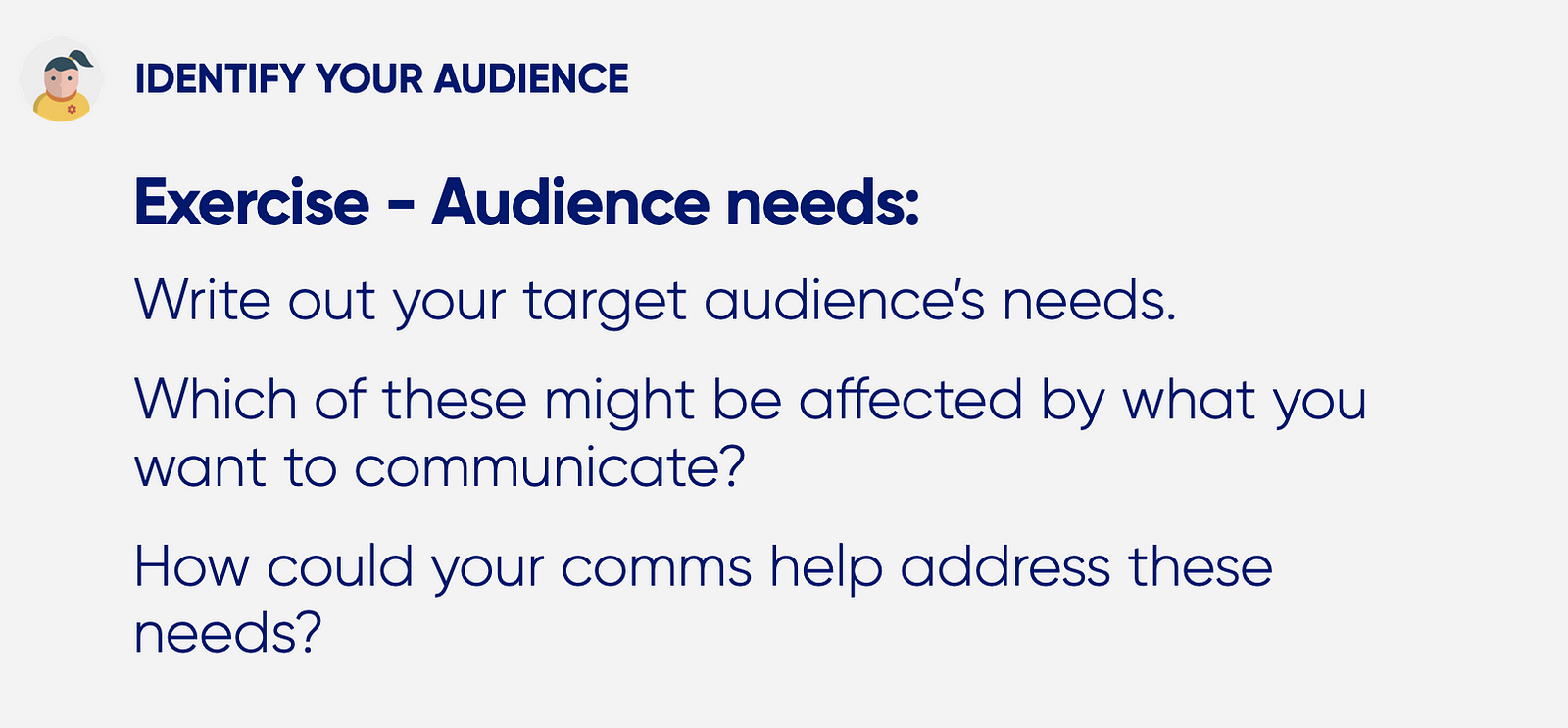
In this third exercise you’ll be looking at your target audiences’ needs. Which of these might be affected by what you want to communicate? And how could your comms help address these needs?
So here’s a simple example:
Let’s say we have a situation where we’re sunsetting a service and need to communicate that to users. People will likely be upset about this for different reasons: their core needs will be affected in different ways.
Example: Sunsetting a service
Belonging: “I won’t be able to connect with my friends!”
Choice: “I wasn’t able to input into this decision!”
Predictability: “I don’t like that this is happening next week”
Significance: “I wasn’t important enough to be informed earlier!”
For certain users it might be their belonging that is effected cause they’re loosing a certain community — so think about ways of acknowledging that or addressing that in your comms.
For others it may be about choice: it might be about providing ways that you can be more flexible, or showing how you’ve taking people’s feedback into account to get to this decision. Or providing alternatives for them to migrate their data to other services.
This is all a bit of a contrived example, but it’s to show that a certain action can have very different effects on the needs of different people.
Recap
So putting that all together, you’ll have a good overview of your audience:
- You’ll understand who they are and what they need to know.
- You’ll understand what they currently think, feel and do, and what you want them to think, feel and do.
- And you’ll understand their core needs.
Now even though I went through these as sequential steps, in reality they can be done in any order. You might have a better idea of what your audience journey is, after you look at their core needs. Or maybe by looking at the core needs, you identify a whole different audience subgroup that you previously hadn’t consider.
The main point of doing these exercises is to better understand who your audiences are and how they might be affected by what you’re communicating, so that we can take all that into account in the following steps.
Stay tuned for the next step where we’ll be looking at designing your comms plan.
This blog post is part of The Art of Communication Design series:
- Part 1: Intro
- Part 2: Define Your Goals
- Part 3: Identify Your Audience
- Part 4: Design Your Comms Plan
- Part 5: Design Each Message
Liked this post? Sign up to my newsletter below to get future blog posts direct in your inbox.
Want to work with me? Get in touch if you want to find out more about engineering management, speaker coaching, outreach and content writing!


